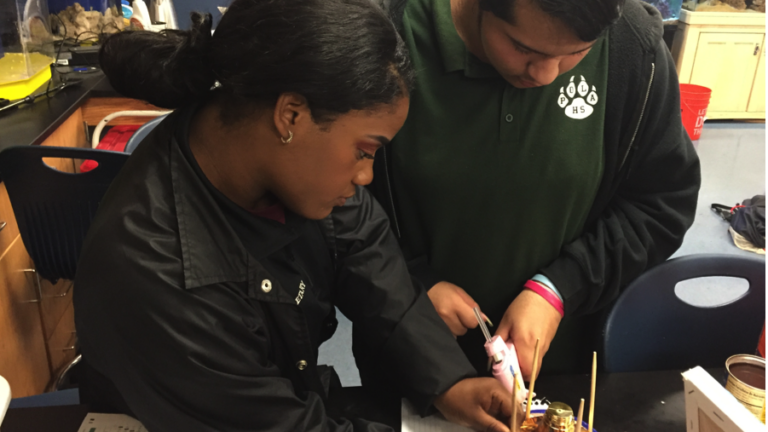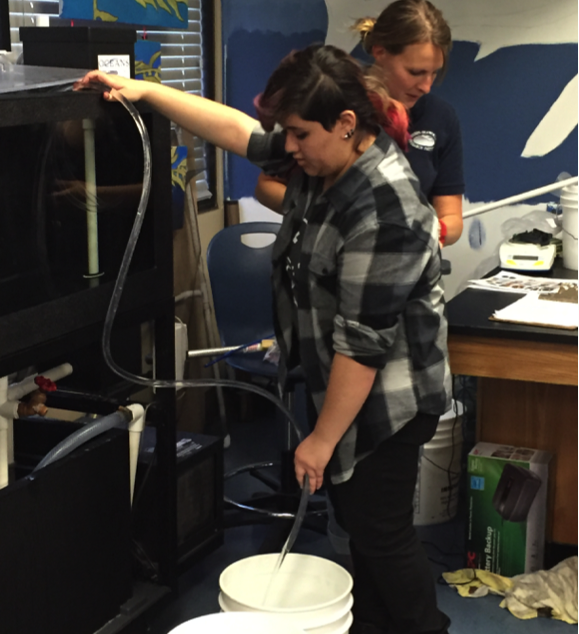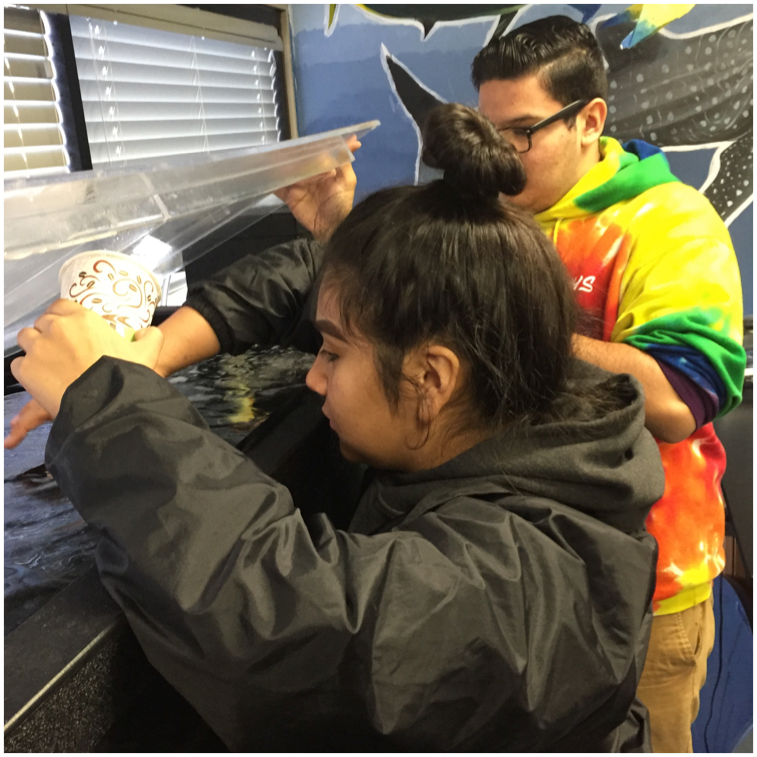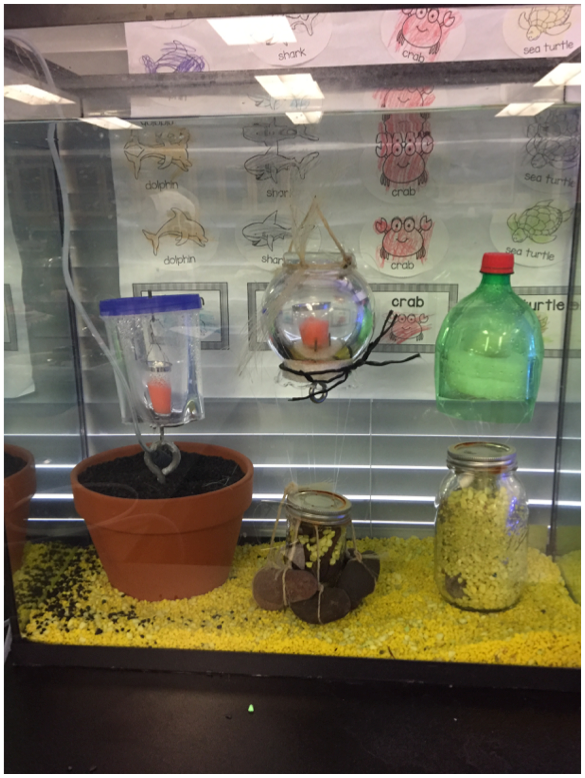
High School Students Help Shape the Future of Aquaculture
It is a Tuesday morning in February and teams of high school juniors and seniors gather in small clusters around aquarium systems throughout their classroom. At one system, small white seabass swim back and forth waiting for their morning meal. Next to the tank are empty buckets, kits to test water quality, and worksheets. Students observe the fish and then grab supplies to test the tank’s water quality. One student records results while the others test levels of pH, ammonia, nitrite and nitrate. As they are working, they are sharing their data and comparing it with previous results to assess changes. Within fifteen minutes, they have a plan in place to siphon a small amount of waste from the bottom of the self-cleaning tank and add back-up water to the system.
 “I feel so smart doing this. I’ve never felt that way before,” says one of the students in this new Aquaculture class at the Port of Los Angeles High School (POLA) in San Pedro.
“I feel so smart doing this. I’ve never felt that way before,” says one of the students in this new Aquaculture class at the Port of Los Angeles High School (POLA) in San Pedro.
Testing water quality is one of a suite of new skills that students gained throughout the year-long class, which wrapped up this past June. It is the first of its kind in Los Angeles, designed and implemented through a partnership between Port of Los Angeles High School and USC Sea Grant, with the goal of providing students with skills and knowledge to begin working in the aquaculture industry.
Currently, there are limited individuals trained and ready to enter the growing aquaculture industry in Southern California. Local community colleges and high schools do not offer programs to build aquaculture workforce skills and most students lack any awareness or skills needed for aquaculture job opportunities.
“Domestic aquaculture will be necessary to meet food supply needs and avoid unsustainable harvesting of decreased wild fish stocks,” said Linda Chilton, Education Programs Manager at USC Sea Grant. “Students will shape this future by making informed decisions as consumers and entering the aquaculture workforce.”
Partners such as Hubbs Seaworld Research Institute, Cabrillo Marine Aquarium, NOAA National Marine Fisheries Southwest Science Center and Long Beach office, Aquarium of the Pacific, OurFoods, and the USC Wrigley Institute for Environmental Studies have provided first hand expertise and field experiences for students to talk with professionals and personally see careers in aquaculture. Through team and individual projects students have demonstrated increases in knowledge and skills across a host of fisheries and aquaculture industry topics.
 The challenges in this class included designing systems that grow seedlings underwater, raising brine shrimp, raising white seabass, creating aquaculture business plans, and designing and engineering a tabletop aquaponics system that would appeal to consumers. Students brought their own strengths to each challenge and applied critical thinking, problem solving, collaboration, communication, and creativity – all essential skills for them to use as they apply the scientific process in approaching challenges beyond the classroom.
The challenges in this class included designing systems that grow seedlings underwater, raising brine shrimp, raising white seabass, creating aquaculture business plans, and designing and engineering a tabletop aquaponics system that would appeal to consumers. Students brought their own strengths to each challenge and applied critical thinking, problem solving, collaboration, communication, and creativity – all essential skills for them to use as they apply the scientific process in approaching challenges beyond the classroom.
“Students, who are often limited by their prior experiences in school or science classes, now have workforce skills and a framework for success in aquaculture,” said Chilton. “Students and their families also have a greater awareness about the benefits of aquaculture and the variety of job opportunities in aquaculture fields – and by identifying job options in their own communities, students also have a chance of working locally.”
“Taking part in the aquaculture class was one of the highlights of my sophomore year,” said student Meghan Vidovich. “I learned fascinating details about, and got a great overall understanding of, the process that is aquaculture. The amount of knowledge I derived from the class on topics such as system construction, chemistry of aquaponics systems, fishing techniques, and the overall successful rearing of plants and fish shocked me, given that I had no idea what aquaculture was when entering the class. I’m grateful to have taken aquaculture, as it is so important to understand in the ever-changing world we live in, and I truly enjoyed studying the subject.”
 Two new Aquaculture classes started this month with support from a Port of Los Angeles Foundation grant to expand the systems the students use. Together, USC Sea Grant and POLA will pursue internship possibilities for students to work in this field.
Two new Aquaculture classes started this month with support from a Port of Los Angeles Foundation grant to expand the systems the students use. Together, USC Sea Grant and POLA will pursue internship possibilities for students to work in this field.
“During the first year of the class students were sent out to restaurants, grocery stores and fish markets with the questions of where the seafood came from and whether or not it was farmed or wild caught,” said science teacher Tim Diktan. “The students were shocked at how many of the employees that they spoke with had no idea. It was amazing to watch the light bulb flip on in the minds of my students as they learned more about this global issue and to leave with a new mindset of how their food is produced, where it comes from, and how their local choices have a ripple effect around our planet. My hope for the upcoming classes is that these switches continue to flip on, making them aware of their choices and the effects that they may have both negatively and positively on our planet.”